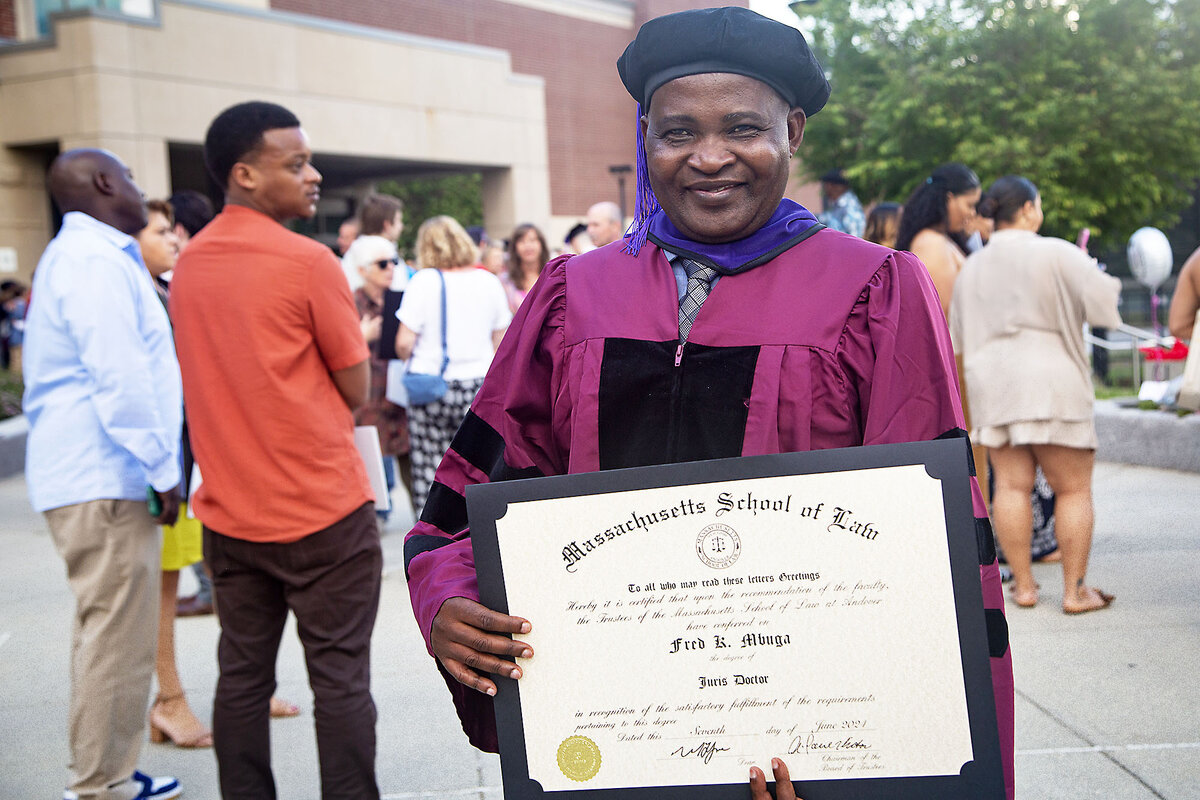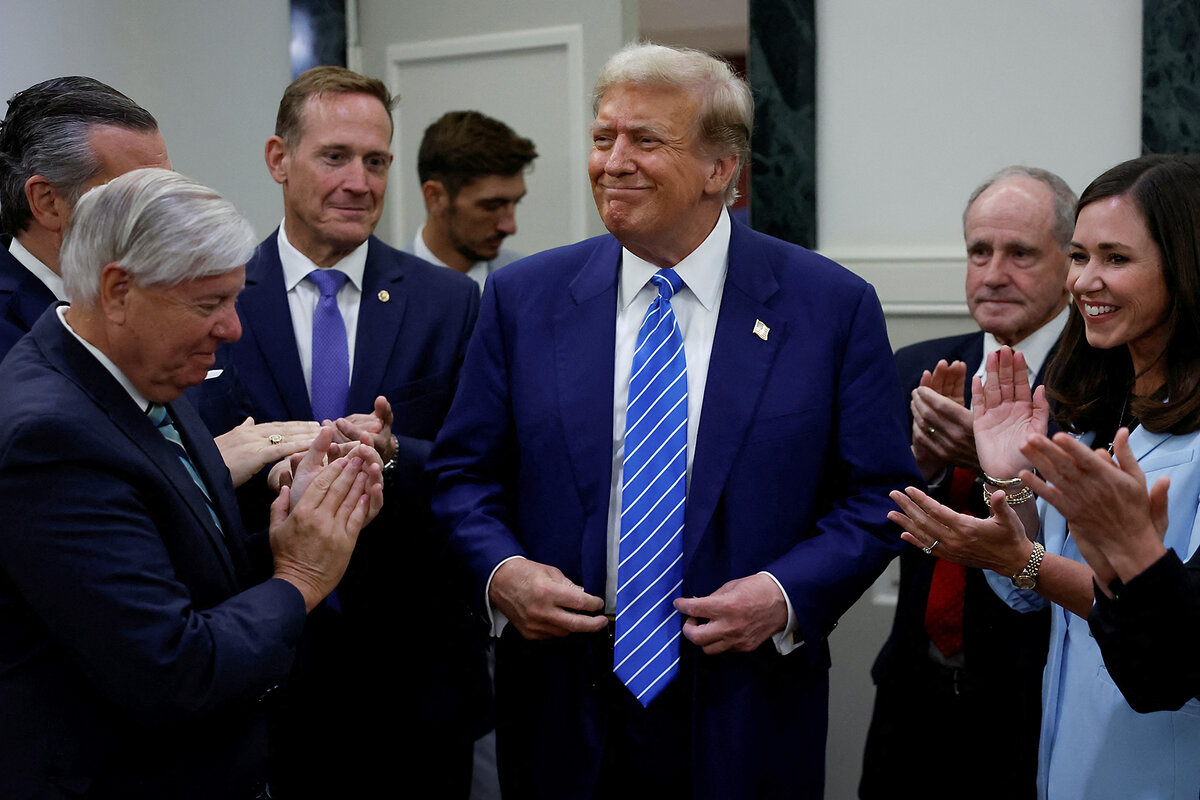In his first visit to Capitol Hill since the Jan. 6 attack, former President Donald Trump highlighted the closer ties he has built with Republicans and how he might leverage them.

Why is Christian Science in our name?
Our name is about honesty. The Monitor is owned by The Christian Science Church, and we’ve always been transparent about that.
The Church publishes the Monitor because it sees good journalism as vital to progress in the world. Since 1908, we’ve aimed “to injure no man, but to bless all mankind,” as our founder, Mary Baker Eddy, put it.
Here, you’ll find award-winning journalism not driven by commercial influences – a news organization that takes seriously its mission to uplift the world by seeking solutions and finding reasons for credible hope.
Explore values journalism About usMonitor Daily Podcast
- Follow us:
- Apple Podcasts
- Spotify
- RSS Feed
- Download
We report today on a former president testing his party’s support on Capitol Hill, and about Russia cozying up to Afghanistan’s Taliban.
Both smart reads as we slide toward the summer of a contentious U.S. election year and as global geopolitical plates keep shifting.
And find the stories that might move you most a little farther down. Among them: Christa Case Bryant’s short, second piece today. It’s a story of connection across continents, of agency and gratitude. It shows the power of journalism – in this case of a 2018 Monitor story – to make a difference in a life.
Help fund Monitor journalism for $11/ month
Already a subscriber? Login
Monitor journalism changes lives because we open that too-small box that most people think they live in. We believe news can and should expand a sense of identity and possibility beyond narrow conventional expectations.
Our work isn't possible without your support.
Today’s stories
And why we wrote them
( 6 min. read )
Today’s news briefs
• G7 summit: The summit of the G7 leading industrialized nations opens in Italy with agreement on a U.S. proposal to back a $50 billion loan to Ukraine using frozen Russian assets as collateral.
• Hamas counters: Secretary of State Antony Blinken says Hamas presented numerous changes, some unworkable, to a U.S.-backed proposal for a cease-fire with Israel in Gaza, but that mediators seek to close the gaps.
• NAACP lawsuit: The Virginia NAACP sues school officials in a rural county after they restored Confederate military names to two schools.
• SCOTUS on Starbucks: In siding with the company, the U.S. Supreme Court makes it harder for the federal government to win court orders when it suspects a company of interfering in unionization campaigns.
• Tom Brady inducted: The former New England Patriot, now in the franchise’s Hall of Fame, provided endless memories and six Super Bowl trophies during his two-decade run with the team.
( 5 min. read )
The Supreme Court’s ruling on an abortion drug Thursday was procedural, but has big consequences. And reactions to the case illustrate why the abortion issue is likely to reach the court again soon.
( 4 min. read )
Much of the world regards the Taliban as outlaw rulers of Afghanistan. But Russia appears set to recognize them anyway, calculating that “the enemy of my enemy is my friend.”
( 5 min. read )
Civil War statues have been in the news in recent years. But a new one in Beaufort, South Carolina, honors a different kind of military leader – and the story only starts there.

( 3 min. read )
At a time of increasing news avoidance by people who feel depressed by conflicts and calamities, news engagement can have the potential to do something very different: inspire and transform lives.
Essay
( 4 min. read )
Sometimes the situation – or person – we are fleeing from turns out to be just the thing we need, as our writer learned about her blessing in disguise.
The Monitor's View
( 3 min. read )
Twenty-nine countries now have female heads of state, which provides a fresh opportunity for a more varied view of how women might lead differently, if at all. One who has been in office for nearly two years in Europe, Italian Prime Minister Giorgia Meloni, on Thursday convened a summit of G7 leading industrialized nations in Puglia, Italy. A newcomer on the scene is Claudia Sheinbaum Pardo, winner of Mexico’s June 2 presidential election.
Although Dr. Sheinbaum won’t take office until October, she is offering clues on her leadership style, listening to citizens about their concerns from crime to education. She offers responses calmly, often with data on solutions. She flies commercial to save public money.
“She has a certain maternal part, like care, but at the same time she makes it very clear that her decisions are made by her, without having to say it,” Renata Turrent, an economist and adviser, told El País. “She navigates those two things in a very graceful way, like a dancer.”
Descriptions like that might make some people wince. Women in politics, business, or academia frequently face obstacles that originate in stereotypes. Take, for instance, cases of women who rely on a conciliatory approach with a foreign adversary. In a paper published in International Studies Quarterly last fall, researchers at Princeton and Carnegie Mellon universities found such women are viewed as acting “according to type,” while a man – pursuing the same sort of diplomacy – is seen as acting in the national interest.
Still, a shift in such social attitudes may also be underway. A study of the pandemic responses of 14 female heads of state, published in the International Journal of Environmental Research and Public Health, found that these leaders “challenged deeply ingrained cultural norms and beliefs about women’s capabilities.” Their success wasn’t based on qualities typically cast as feminine – but came through “decisive and timely action, clear communication, and risk-averse decision-making.”
Those attributes may now shape debates about European security at the G7 summit. Once dismissed as a hard-right populist, Ms. Meloni has gained a reputation among her peers for pragmatism. One convert is the head of the 55-nation African Union, Moussa Faki Mahamat. He has praised the Italian prime minister for seeking solutions to mass migration through Africa that transform “the vast regions of poverty, exclusion and human suffering into a space of prosperity and development” through partnership.
In her own way, Dr. Sheinbaum, a climate scientist and longtime leftist, takes a similar approach. As a student activist leader challenging attempts to privatize public education, she exhorted her peers to seek constructive dialogue. “Let’s not fall into provocations,” she urged.
“Women bring another dimension to leadership,” Ellen Johnson Sirleaf, former president of Liberia and the first female head of state in Africa, told Time recently. “They settle conflict rather than fight to resolve it. That does not take away from the application of the strength of authority when required, but when they can find an alternative route to peace, they seek it.”
A true picture of female leadership, free of stereotypes, may be emerging as more countries and businesses elevate women to higher roles. In the meantime, examples from Mexico to Italy help expand the picture of what is possible for all.
A Christian Science Perspective
Each weekday, the Monitor includes one clearly labeled religious article offering spiritual insight on contemporary issues, including the news. The publication – in its various forms – is produced for anyone who cares about the progress of the human endeavor around the world and seeks news reported with compassion, intelligence, and an essentially constructive lens. For many, that caring has religious roots. For many, it does not. The Monitor has always embraced both audiences. The Monitor is owned by a church – The First Church of Christ, Scientist, in Boston – whose founder was concerned with both the state of the world and the quality of available news.
( 3 min. read )
An understanding that God’s spiritual goodness is infinite can empower us to see and feel this goodness in our own lives and beyond.
Viewfinder

A look ahead
Thanks for reading today. Come back tomorrow for a new set of reports. We’ll look at how voters in a Colorado swing district view recent U.S. action on the southern border, and at what the field of candidates for a special election to replace President Ebrahim Raisi, killed last month in a helicopter crash, tells us about what’s next for the Islamic Republic of Iran.









